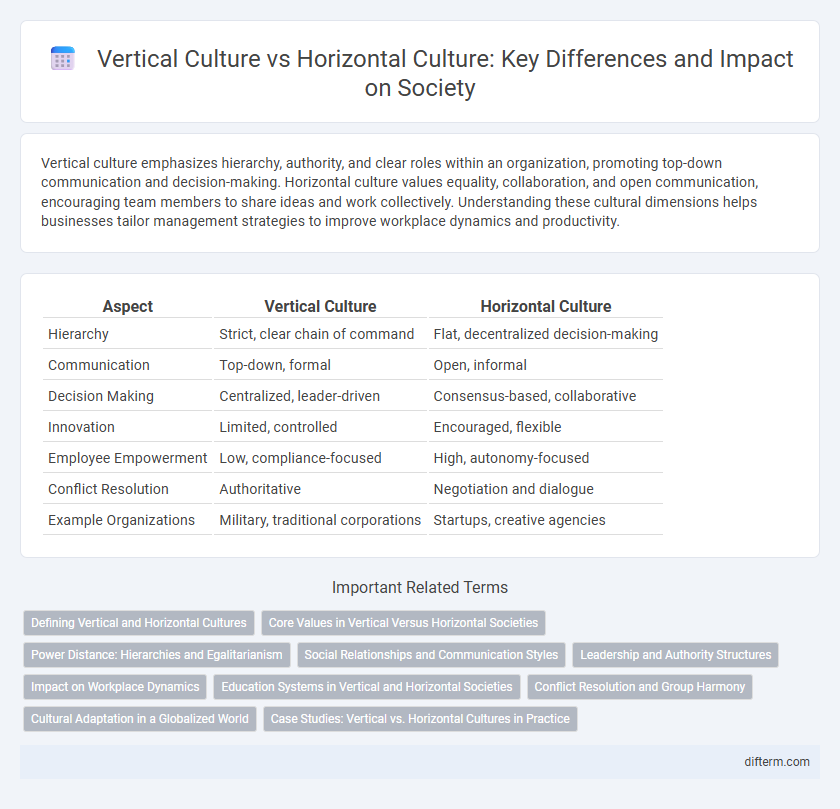Vertical culture emphasizes hierarchy, authority, and clear roles within an organization, promoting top-down communication and decision-making. Horizontal culture values equality, collaboration, and open communication, encouraging team members to share ideas and work collectively. Understanding these cultural dimensions helps businesses tailor management strategies to improve workplace dynamics and productivity.
Table of Comparison
| Aspect | Vertical Culture | Horizontal Culture |
|---|---|---|
| Hierarchy | Strict, clear chain of command | Flat, decentralized decision-making |
| Communication | Top-down, formal | Open, informal |
| Decision Making | Centralized, leader-driven | Consensus-based, collaborative |
| Innovation | Limited, controlled | Encouraged, flexible |
| Employee Empowerment | Low, compliance-focused | High, autonomy-focused |
| Conflict Resolution | Authoritative | Negotiation and dialogue |
| Example Organizations | Military, traditional corporations | Startups, creative agencies |
Defining Vertical and Horizontal Cultures
Vertical culture emphasizes hierarchy, authority, and clearly defined roles within organizations or societies, promoting top-down decision-making and structured communication. Horizontal culture values equality, collaboration, and open communication, encouraging team-based approaches and shared responsibilities across all levels. Understanding these cultural dimensions aids in tailoring leadership styles and improving organizational effectiveness in diverse environments.
Core Values in Vertical Versus Horizontal Societies
Vertical cultures prioritize hierarchy, status, and clear social roles, embedding core values such as respect for authority, tradition, and conformity. Horizontal cultures emphasize equality, collaboration, and shared responsibilities, reflecting core values like fairness, openness, and mutual support. Understanding these contrasting core values aids in navigating social dynamics and organizational behaviors across diverse cultural settings.
Power Distance: Hierarchies and Egalitarianism
Vertical cultures emphasize power distance, valuing clear hierarchical structures where authority and decision-making flow top-down, often leading to centralized control and respect for rank. Horizontal cultures prioritize egalitarianism, promoting equal power distribution, collaborative decision-making, and open communication across organizational levels. Understanding power distance in cultural contexts is essential for managing cross-cultural interactions and fostering effective teamwork.
Social Relationships and Communication Styles
Vertical culture emphasizes hierarchical social relationships with clear authority levels, influencing formal communication styles that prioritize respect and deference. In contrast, horizontal culture fosters egalitarian social interactions, promoting open, informal communication that encourages collaboration and equal participation. These differences impact workplace dynamics, decision-making processes, and interpersonal engagement across cultural contexts.
Leadership and Authority Structures
Vertical cultures emphasize hierarchical leadership and clear authority structures, where decision-making is centralized at the top levels of an organization. In contrast, horizontal cultures promote distributed leadership with shared authority, encouraging collaboration and egalitarian decision-making processes. Power distance index (PDI) scores often illustrate these differences, with vertical cultures showing high PDI and horizontal cultures having low PDI.
Impact on Workplace Dynamics
Vertical culture emphasizes hierarchy and clear authority lines, often resulting in structured decision-making and defined roles within the workplace. Horizontal culture promotes collaboration and equality, fostering open communication and increased team cohesion. These contrasting cultural frameworks significantly shape employee engagement, conflict resolution, and innovation capacity in organizations.
Education Systems in Vertical and Horizontal Societies
Education systems in vertical cultures emphasize hierarchical structures, standardized testing, and teacher-centered learning, fostering respect for authority and clear social roles. Horizontal cultures promote collaborative learning, critical thinking, and equal teacher-student relationships, encouraging creativity and peer interaction. These differing approaches shape individual behavior and societal values, influencing innovation, communication styles, and conflict resolution in each culture.
Conflict Resolution and Group Harmony
Vertical cultures emphasize hierarchy and clear authority in conflict resolution, often relying on top-down mediation to restore group harmony. Horizontal cultures prioritize equality and open dialogue, encouraging collective decision-making to address conflicts. Maintaining group harmony in horizontal cultures involves inclusive communication and mutual respect, minimizing power dynamics.
Cultural Adaptation in a Globalized World
Vertical cultures emphasize hierarchical structures and clear authority lines, impacting communication and decision-making processes. Horizontal cultures promote egalitarian relationships and collaboration, fostering flexibility and innovation in diverse teams. Adapting to globalized environments requires understanding these cultural dimensions to navigate cross-cultural interactions effectively and enhance organizational cohesion.
Case Studies: Vertical vs. Horizontal Cultures in Practice
Case studies of vertical versus horizontal cultures demonstrate significant differences in organizational hierarchy and communication flow, impacting employee engagement and decision-making efficiency. Vertical cultures, characterized by top-down authority and clear rank distinctions, often excel in industries requiring strict control and quick compliance, such as the military and manufacturing sectors. Horizontal cultures, emphasizing egalitarianism and collaborative teamwork, promote innovation and adaptability, as seen in technology startups and creative agencies.
vertical culture vs horizontal culture Infographic

 difterm.com
difterm.com